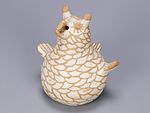Owl Figure
About this object
Narrative
Pottery owls became important tourist items when the railroad and then Route 66 allowed for large numbers of tourists to travel to the Southwest. This collection of 192 Zuni pottery owls includes examples from before 1900 through 2006. Zuni potters continue to make owls and family traditions in the medium continue. While many younger potters are innovating, the owls are distinctly Zuni.
Iconographic meaning
In traditional Zuni lore, the owl is considered a wise guardian and protector. An owl’s ability to see at night means that it sees what others cannot, giving it understanding of the spiritual and physical world.
Physical description
Wobbly, gourd-shaped clay owl is hand painted in yellowish brown and yellow over a creamy white burnished background. Small striped wings and tail spread upward, as if flapping. and thickly outlined overlapping feathers cover most of the body. Finger-like ears stick up from head, beak loops to the front, and eyes have thick lashes.
Date Made
1910-1929
Date Acquired
24 Feb 2009
How Acquired
Donated
Credit Line
The David Evans & Daniel Ma Southwest CollectionMore...
Measurements
Overall: 18.5 cm x 19 cm x 17 cm
Object Number
2731/191
